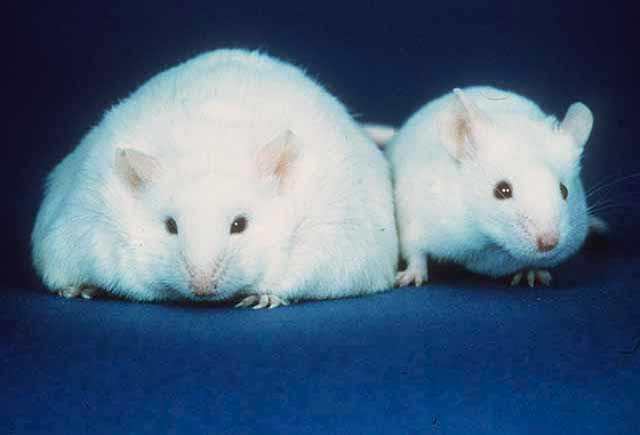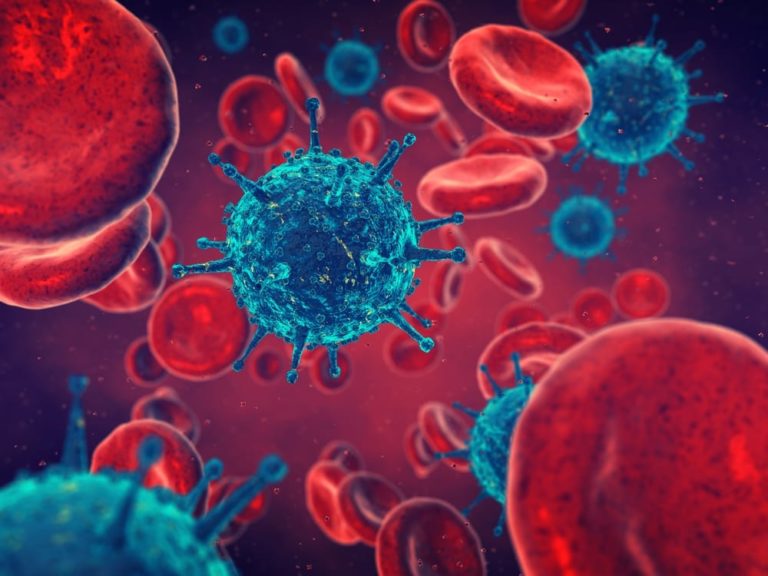The fatty tissue? This is for saving. It stores fat. This is what most people know about adipose tissue. But did you know that your fat tissue can do much more? Throughout the day, it releases hormones. With this ability, it is the largest hormone-active organ in our body.
First, we need to clarify what “the fat tissue is”. There are white and brown adipose tissues. White adipose tissue is used to store triglycerides, or fats. The brown adipose tissue stores less fat, but can heat up our body like a hot water bottle, keyword “thermogenesis” – but we will deal with that another time. Today we are talking about white adipose tissue, storage adipose tissue. This adipose tissue consists of white fat cells (adipocytes). Like any other cell, they have a nucleus, mitochondria and all the other building blocks of human (animal) cells. The main feature is a large vacuole. This is a storage station for the fat. A thick fat droplet containing triglycerides. This means that not the whole cell is filled with fat, but only this vacuole. This allows the other areas of the cell to work undisturbed on cell division and other important things. The vacuole takes up most of the space in the cell and all other cellular components are thereby squashed flat against the cell membrane. Being a nucleus in an adipocyte is probably not the most comfortable position. But well, someone has to do this job too.
1. the adipose tissue contains not only fat cells
The white adipose tissue is well permeated with very fine veins – blood capillaries – to ensure the supply of cells and to enable the supply and removal of storage fats. In addition to fat cells, fibroblasts (connective tissue cells), monocytes and macrophages (cells of the immune system) are also found in adipose tissue.
2. why does the adipose tissue secrete hormones?
“… and why do we have fatty tissue at all?”, you might think “that’s some pretty annoying, unsightly stuff”. Nope! Let’s turn the view around and think through the whole thing from the point of view of evolution. There are a few people sitting around a campfire and grilling a wild boar. Everyone eats a portion, chews each bite 30 times, drinks a glass of water with each bite, says “I’m full” and they leave the rest of the boar to avoid feeling full. The wild boar remains are dragged away by other animals. The next day, our little folk develops hunger again, but oh dear, Mother Nature doesn’t send a wild boar in front of them today. Hunger increases, they feel weak, get tired and fall asleep. Forever. Do we agree that we won’t get far with this system? Good. So these people need something with which they can store energy as long as there is something to eat. It’s lucky that fatty tissue exists. So our people sit around the campfire, don’t give a damn about chewing and really fill their bellies with wild boar. After all, they don’t know when they’ll find one next. So always put it in. In the end, they are stuffed and fall asleep happily. They burn off some of the wild boar’s energy right away. Everything they don’t currently need is converted into fat and stored in adipose tissue. The next day they do not catch a wild boar. But that’s not a problem, because their body switches to fat burning and ketosis(sound familiar?) and their muscles and brains are supplied with energy from fat tissue. When the stores run low, hunger increases and with it the urge to find something to eat again.
Does hunger know no bounds?
What if the wild boars came by voluntarily every day? Would our people then dig in day after day and their fat stores become fuller and fuller? Hardly. Because deep inside, her biochemistry knows that the day may come when wild boars will no longer dance by like in the land of milk and honey. Then it’s hunt…. and with 200 kg on the scales and wobbling fat stores, it’s somehow not so good to hunt.
That’s why evolution has built a lot of regulatory mechanisms into our bodies. So that we fill up our stores at the right time and stop again at the right time in order to remain agile people. The most important regulatory mechanism is controlled by a hormone from adipose tissue: leptin. All other hormones and substances secreted by the adipose tissue also serve primarily to regulate: Are new fat cells currently to be formed? Should hunger increase? Should the person up there move less?
Junk food overrides regulation
Small side note: Yes, we have successfully managed to override many of these regulatory mechanisms through “modern food.” Congratulations food industry! Therefore, the task of good nutrition is also to bring hormonal regulation back to its natural path.
3. leptin - a hormone from adipose tissue.
The best known hormone secreted by adipocytes is leptin. It is encoded by the “obese” gene. Over 60 years ago, a laboratory mouse was discovered rather by accident, and it just kept getting fatter and fatter. While her peers stopped eating after adequate food intake, the “whether/if” mouse kept eating and eating. The reason was a genetic defect – this mouse lacked the “obese” gene, which contains the information for leptin, therefore also called ob/ob mouse (the gene was missing on the chromosome of the mother, as well as on the chromosome of the father, so the anomaly was homozygous. The gene defect is inherited recessively). Although mice with this genetic defect had been known for a long time, the hormone leptin was not discovered until 1994.
Leptin is secreted by white fat cells and binds to receptors in the brain. There it provides information about how large the fat stores currently are. If the fat stores decrease, less leptin is produced. If the amount of reserves increases, more leptin is released. Leptin blocks the release of two appetite-stimulating substances in the brain (AgRP = agouti related protein and NPY = neuropeotide Y). Fewer appetite-stimulating substances means less appetite. At the same time, leptin stimulates the release of two appetite-suppressing substances in the brain (POMC = proopiomelanocortin and CART = cocaine- and amphetamine-regulating transcript). So leptin has an effect on satiety and that makes sense: the more reserves we have, the less we need to replenish. When fat reserves run low, leptin concentration drops and the effect is reversed: hunger increases.
At the same time, leptin also stimulates the sympathetic nervous system, causing blood pressure to rise, heart rate to increase, and brown adipose tissue to perform more thermogenesis. Energy consumption increases.
In the opposite case, the energy consumption decreases. Ah, there it is: the dreaded drop in basal metabolic rate! But you can get everything under control again with the right (and sufficient) diet.
Leptin as an appetite suppressant
Now you might think: “Easy-peasy, we can safely produce leptin in a test tube and poof we have THE perfect appetite suppressant and weight loss agent”. Yes, some people have already come up with this and injected overweight people with leptin. And what happened? Nüscht.
Severely overweight people have lots of fatty tissue. Lots of adipose tissue means lots of white fat cells producing lots of leptin. Lots of leptin in the bloodstream, lots of leptin in the brain… and still they gain weight? Why? At some point, the regulation failed and the balance of energy intake and consumption was disturbed. Two possible reasons are emotional eating and eating the wrong foods. We are taught from childhood that food is more than just a means to satisfy hunger – so we simply ignore our satiety. At the same time, the food industry is doing everything it can to bring ever more addictive products to market. The right ratio of sugar to fat can very well override our natural satiety mechanisms. 50:50 is such a devilish ratio. 50% carbohydrates, 50% fat…. Chocolate (sugar + cocoa butter), chips (potatoes + oil), ice cream (sugar and cream)….
So we ignore the saturation effect or it is bypassed with such combinations. We gain weight, more and more – and at some point the natural hunger doesn’t show up anymore – all the sluices are open and we could just eat all day. Why?
Leptin. Leptin, or rather a malfunction of leptin signaling, is the underlying control mechanism when we can eat and eat, no matter how much it was and no matter how full our reserves already are. This is because, as described above, leptin levels continue to rise as reserves increase. We could stop eating now because we are getting full, but we are not. We continue to eat despite being full because we want to reward ourselves, are sad, or the food is “addictive.” Then, at some point, the point is reached where masses of leptin are in the body. The brain continuously receives the info “Hello brain, this is the fat tissue, my cells are sufficiently filled”. The brain sets to “full” but nothing happens. More fat enters the adipose tissue, the cells are filled to bursting and the adipose tissue reports “Hello brain. Here is your fat. Enough is enough”. The brain switches to “full” but we continue to eat. To prevent the fat cells from bursting, the fat tissue expands and new fat cells are formed. “HELLO BRAIN! This is your fat tissue talking!!! We are really getting short on space here! Would be very nice if you would finally tell your human to stop eating!”. The brain tells the person “we are full”. Man keep eating, tastes so good and grandma cooked it. “EY BRAIN! IF YOU DON’T MAKE SURE IT’S QUIET AROUND HERE SOON, DUDE!”. The brain back “Ey fat, now pay attention. I’ve been telling this person all along that he’s full, what else should I do, bandage his mouth? Great, and I’m allowed to be yelled at by you. You and your leptin buddies are always coming up here. You know what? That’s enough! Fuck both of you. You fat tissue, talk with your hand, your head doesn’t listen to you. And you human: it’s your own fault… then keep eating. I don’t feel like it anymore. You are welcome to negotiate, but without me”. Zack. Boom. Leptin resistance.
Leptin resistance - when the brain goes into overdrive
Now the adipose tissue can release as much leptin as it wants. The info no longer reaches the brain. There is no point in injecting leptin through the crook of the arm into this overweight person. The info no longer arrives. The brain is numb, had a hearing loss in relation to leptin and simply no longer had the strength to take in the message. The saturation mechanism is overridden. And although the fat stores are filled to bursting… you are hungry and starving.
This leptin resistance can only be reversed by dwindling fat reserves. Lose weight, to a normal weight. Because only when the lepting cry goes back can you get the brain to listen again. You can’t listen to the birds chirping when the jackhammer is hitting the asphalt next to you. But as soon as the jackhammer stops making noise, your ears just need to settle down a bit and you’ll hear the birds again. Thus, leptin resistance is also – fortunately – reversible.
Massive energy is saved when underweight
So, but now a completely different topic. Away from obesity: even when underweight, leptin leads to regulation. When you lose a lot of weight or go on the wrong (crash) diet, your leptin levels drop and that leads to cravings to replenish your reserves. If a person does not pursue this hunger, but continues to lose weight (into underweight), the falling leptin level leads to less energy being consumed: The body temperature drops, one freezes, hair growth slows down and the reproductive capacity is stopped (the period stops). So leptin has an immense effect on our body. This hormone from fat tissue has an influence on almost every bodily function.
A lifetime ketogenic diet? Not necessarily advisable
By the way, when dieting too low in calories or severely restricting carbohydrates, leptin levels drop faster than fat reserves. The info “here is a state of emergency” arrives in the brain before there is even a real state of emergency. That’s why I never recommend going below 1600 (healthy Paleo) calories, only for very inactive and petite people it can be 1400 times as a minimum. In addition, if you are following a low-carb diet, you need to listen to your body. I recommend a ketogenic diet for 30 days to 3 months at a time until all adaptations have taken place. After that, however, you should do a refeed once a week, or even twice a week if you are a woman (eat 150-300 g of carbohydrates from rice, potatoes, sweet potatoes or pumpkin one evening a week), so that the leptin release is stimulated again. This way, you can follow a ketogenic diet in a healthy way, even in the long term. If you are coming from a higher weight, even 6-12 months at a stretch can be problem-free, but I always like to look at each person individually here and only then decide how long at a stretch a ketogenic diet is suitable, and when the body needs a leptin boost from carbohydrates again.
4. what other hormones does the adipose tissue secrete?
The fatty tissue secretes “adipokines”, for example. These are the names of hormones and substances that are secreted from the fatty tissue). Besides leptin, other hormones include adiponectin, resistin, visfatin, and hepicidin. They influence and regulate glucose metabolism, fat metabolism and the feeling of hunger.
Other substances are inflammatory factors, coagulation factors or the transcription factor TNFα (TNF-alpha = tumor necrosis factor alpha). These cytokines mainly regulate the differentiation of stem cells into further adipose tissue cells, but are also associated with inflammatory diseases, type II diabetes and coagulation disorders.
Health lies in the middle
We should all be concerned about keeping our fat reserves within a natural range. Not too much and not too little.
Good luck with it!
Cheers, Marina
Always stay up to date with our Newsletter.
Further reading:
Castracane, Henson. 2007. the Obese (ob/ob) Mouse and the Discovery of Leptin, Volume 25 of the series Endocrine Updates pp 1-9.
Daniel, Rehner. 2010. Biochemistry of Nutrition, Springer Spektrum.
Hered. 1950. Obese, a new mutation in the house mouse, Journal of Heredity.
Neumann et al, Adipocytokines as driving factors in rheumatoid arthritis, Deutsche Gesellschaft für Rheumatologie e.V..









